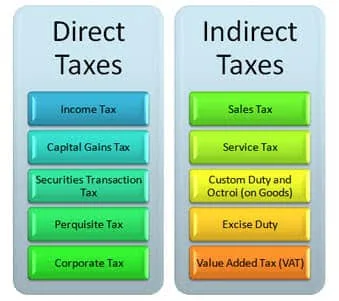Taxes are an essential source of revenue for any government, facilitating the provision of public services such as education, healthcare, infrastructure, and national defense. Tax systems are designed to collect funds in a way that is fair and effective, and they typically include both direct and indirect taxes. Understanding the difference between these two types of taxes is crucial for citizens and businesses alike, as it affects how they pay taxes and what they pay them on.
In this article, we will explore the key differences between direct and indirect taxes, examples of each, and the role they play in a nation’s economy.

What Are Direct Taxes?
Direct taxes are taxes that are directly levied on an individual or organization and are paid directly to the government. These taxes cannot be transferred to someone else, and the responsibility of paying them lies solely with the taxpayer. In other words, the person who is taxed is the one who ultimately bears the burden of the tax.
Characteristics of Direct Taxes:
- Paid Directly by the Taxpayer: The most distinctive feature of direct taxes is that they are paid directly to the government. This could be individuals, companies, or organizations.
- Non-transferable: The taxpayer cannot transfer the responsibility of paying the tax to someone else, unlike indirect taxes, where the burden can shift.
- Based on Income or Wealth: Most direct taxes are based on an individual’s income, wealth, or property value. The more income or assets you have, the more you are likely to pay.
- Progressive in Nature: Direct taxes, especially income taxes, are often progressive. This means that the tax rate increases as the taxable amount (such as income or property value) increases.
Examples of Direct Taxes:
- Income Tax: One of the most common direct taxes, income tax is levied on the earnings of individuals or businesses. The rate may vary based on income brackets, with higher income earners paying a higher percentage of their income in taxes.
- Corporate Tax: This tax is levied on the profits of companies. Corporate tax rates vary by country and may depend on the size of the company and its profits.
- Wealth Tax: Some countries impose a wealth tax on individuals who have a net worth above a certain threshold. This tax is calculated based on the total value of assets like property, stocks, and other investments.
- Property Tax: Local governments often levy property taxes on the value of an individual’s real estate. The property tax is typically assessed annually and is used to fund local services such as schools, public safety, and infrastructure.
- Inheritance Tax: Also known as estate tax, this is levied on the transfer of wealth upon an individual’s death. It is usually calculated on the value of the estate inherited by beneficiaries.
Advantages of Direct Taxes:
- Equity and Fairness: Since direct taxes are based on an individual’s income or wealth, they are generally considered more equitable. Higher earners pay more, which helps reduce inequality.
- Stable Revenue Source: Direct taxes often provide a stable and predictable revenue stream for the government.
- Progressive Nature: Progressive tax systems, like income tax, help reduce income inequality by taxing higher income levels at higher rates.
Disadvantages of Direct Taxes:
- Complexity: Direct taxes can be complex to administer and require detailed records and filings. This can lead to compliance costs for both the taxpayer and the government.
- Tax Evasion: High-income individuals and corporations may try to evade taxes through loopholes or tax avoidance strategies.
- Economic Disincentives: High tax rates, especially on income, may discourage work, investment, or entrepreneurial activities.
What Are Indirect Taxes?
Indirect taxes are taxes that are levied on goods and services rather than on income or wealth. These taxes are collected by intermediaries (like businesses) who then pass them on to the government. While the tax is ultimately paid by the consumer, it is collected and remitted by businesses on behalf of the government.
Characteristics of Indirect Taxes:
- Paid by Consumers: The ultimate burden of indirect taxes falls on the consumer, who pays the tax when purchasing goods or services.
- Transferable: Businesses have the ability to pass on the cost of the tax to consumers in the form of higher prices. This makes indirect taxes “transferable” in nature.
- Based on Consumption: Unlike direct taxes, indirect taxes are generally based on consumption. The more a consumer buys, the more they pay in indirect taxes.
- Regressive in Nature: Indirect taxes can be regressive, meaning they may disproportionately affect lower-income individuals, as they spend a larger portion of their income on taxable goods and services.
Examples of Indirect Taxes:
- Sales Tax: A sales tax is a tax levied on the sale of goods and services. The retailer collects the tax from the buyer at the point of sale and remits it to the government. Sales tax rates may vary depending on the state or country.
- Value Added Tax (VAT): VAT is a consumption tax that is applied at each stage of the production or distribution process. It is added to the price of goods and services and is ultimately borne by the consumer.
- Excise Duty: Excise taxes are levied on specific goods, such as alcohol, tobacco, and fuel. The manufacturer or importer of these goods typically pays the tax, but the cost is often passed on to the consumer in the form of higher prices.
- Customs Duty: A customs duty is a tax imposed on goods imported into a country. Like excise duties, the cost is generally passed on to consumers in the form of higher prices for imported goods.
- Sin Taxes: These are specific taxes on goods and services that are considered harmful or undesirable, such as tobacco, alcohol, or sugary drinks. These taxes are designed both to generate revenue and to deter consumption of certain products.
Advantages of Indirect Taxes:
- Ease of Collection: Indirect taxes are easier to collect than direct taxes because businesses collect them on behalf of the government, reducing the need for individual taxpayers to file returns.
- Wider Tax Base: Almost everyone pays indirect taxes, making it a more inclusive method of taxation. It applies to consumers of all income levels.
- Less Evasion: Since the tax is built into the price of goods and services, there is less opportunity for tax evasion compared to direct taxes.
Disadvantages of Indirect Taxes:
- Regressive Nature: Indirect taxes are often considered regressive because they take a larger percentage of income from lower-income individuals than from higher-income individuals. Since everyone pays the same tax rate on goods, those with lower incomes are affected more heavily.
- Price Increase: Indirect taxes can increase the price of goods and services, which may lead to inflationary pressures in the economy.
- Economic Distortion: High levels of indirect taxes on certain goods can distort consumer behavior, causing people to either reduce consumption or shift to untaxed or illegal alternatives.
Key Differences Between Direct and Indirect Taxes
| Feature | Direct Taxes | Indirect Taxes |
|---|---|---|
| Who Pays the Tax | Paid directly by the individual or organization | Paid by the consumer, collected by businesses |
| Transferability | Cannot be transferred to another person | The tax burden can be passed on to consumers |
| Basis of Taxation | Based on income, wealth, or property | Based on consumption or goods/services |
| Examples | Income tax, corporate tax, property tax | Sales tax, VAT, excise duty |
| Progressiveness | Often progressive (higher rates for higher income) | Typically regressive (affects low-income more) |
| Complexity | More complex to calculate and administer | Easier to collect, as businesses handle it |
Conclusion
Both direct and indirect taxes are integral to a nation’s tax system, each serving different purposes and having distinct advantages and disadvantages. Direct taxes are typically based on an individual’s or business’s income or wealth, and are progressive, ensuring that those who can afford to pay more contribute more. Indirect taxes, on the other hand, are primarily consumption-based and are easier to collect but tend to disproportionately affect lower-income individuals.
A balanced tax system typically relies on a combination of both types of taxes to ensure fairness, economic stability, and sustainable public revenue. Understanding the differences between these taxes helps citizens make informed financial decisions and ensures that they comply with their tax obligations.
